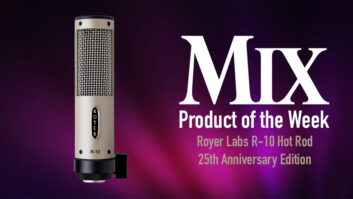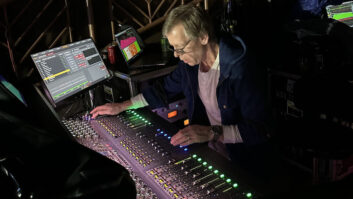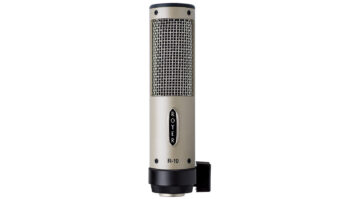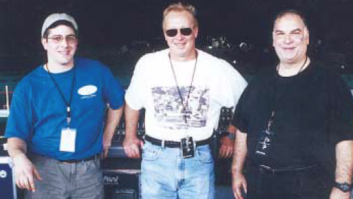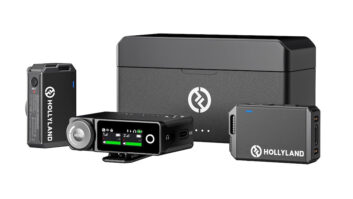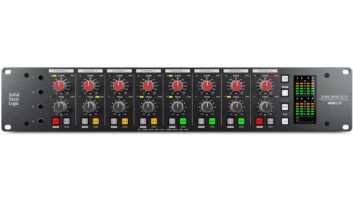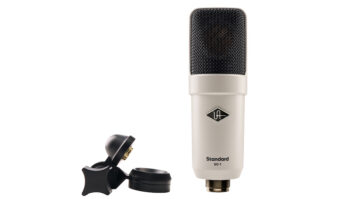If you’re like us, you’re addicted to microphones—new or old,condenser or dynamic—and with an ever-increasing supply ofinteresting new debuts, we’re constantly scouring the world forinteresting new mics.
With this in mind, we thought it would be fun to spotlight themicrophones that our editors have selected as hits of major pro audioconventions over the past few years. These tradeshows are presented inreverse-chronological order (with the most recent events first) anddirect links are provided to each manufacturer for quick access to moreinformation.
Fall AES
New York City—November 30 to December 3, 2001
Reported in the January 2002 Mix
There was no small amount of apprehension in the air when therescheduled 111th Audio Engineering Society convention opened at NewYork City’s Javits Center on November 30. With an understandablereticence to travel—especially from overseas visitors—and anumber of key manufacturers (such as AMS Neve, Digidesign, EAW/Mackie,Meyer, Roland, Steinberg, Tannoy/TGI and Yamaha) canceling theirexhibits, no one knew exactly what to expect.
The 111th AES could have been a failure, but it was an enormoussuccess. True, many exhibitors brought smaller booths (maybe not such abad idea after all), but the aisles were packed with showgoers, and theabsence of some companies on the show floor created opportunities fortheir competition.
The overall vibe was upbeat, and many attendees likened this AES tothe smaller shows in years past when the convention was held at theHilton or Warwick hotels. Even the climate cooperated, with sunny skiesand unseasonably warm weather adding to the smiles of the locals whowelcomed the return of some normalcy (and visitor spending) to The BigApple. Walking the AES show floor, we found no shortage of cool newproducts.
At AES, Royer (www.royerlabs.com) introduced Active Ribbon Mics,the world’s first active, phantom-powered ribbon models. Based onRoyer’s current R-121 and SF Series ribbon mics, these models featureall-discrete, low-noise FET head amps, making them as sensitive ascondenser mics, eliminating the need for ultra-high-gain preamps.
Shure‘s (www.shure.com) $575 KSM27 is a cardioid condenserwith low self-noise, Class-A, transformerless preamp circuitry and anultra-thin, 1-inch diaphragm for extended 20-20k Hz frequencyresponse.
AKG (www.akgusa.com) debuted the C 451B, asmall-diaphragm condenser based on the transducer from its original C451 EB + CK 1, but in a cardioid-only (non-interchangeable capsule)version with switchable 10/20dB pads, two-step highpass filtering, andnew transformerless, low-noise electronics. Retail: $549.
Now independent of Alesis, Groove Tubes (www.groovetubes.com) showed a full line of newmics, featuring the GT66, a 1.10-inch diaphragm, cardioid model with6205 Triode tube electronics and 20kHz bandwidth. Retail is $1,099,with shockmount and power supply. The GT55 puts the same large capsulein a Class-A FET version that’s $599. GT also debuted some coolmid-sized (¾-inch diaphragm) mics with cardioid capules(interchangeable omni or hypercardioid elements are optional), in achoice of Class-A FET (GT33, $599) or tube (GT44, $999) flavors.
Transamerica Audio Group (www.transaudiogroup.com)—which distributesAEA, Soundfield, Brauner and Soundelux—seemed like microphonecentral. Soundelux unveiled the E47, a large-diaphragm, multipatterntube mic that’s modeled to sound like the classic Neumann U47(retailing at half of the average price of a “vintage”U47). Given Soundelux’s success with its Telefunken ELAM 251-inspiredELUX 251, the new E47 will be a hot ticket. Audio EngineeringAssociates’ R-440 Stage Prop Mic ($495) is a full-size RCA 44-style micshell with internal shockmount for inserting a compact side-addressmic—it seems live prop use with your own mic can be practical.Brauner’s Valvet Voice® limited-edition tube mic builds on thepopularity of Dirk Brauner’s Valvet and VM1, in a cardioid model withClass-A electronics, custom Lundahl transformers and JAN tubes.
Studio Projects‘ (www.pmiaudio.com) B Series of 1-inch diaphragmcondenser mics resemble its popular C Series, but at a lower price. The$99 B1 is a solid-state, single-pattern design. The TB1 is a tubeversion of the B1 at $399 with PS and aluminum carry case. The $199 B3is a solid-state model with switchable cardioid, omni, figure-8 polarpatterns.
Designed with a rising 4k to 12k response for diffuse-fieldorchestra/ambience/choir miking, the omni M960 from MicrotechGefell (www.gefell-mics.com) puts a large condenser capsuleinto an unobtrusive, small body. Retail: $795.
Just over an inch in diameter, the CUB-01 Universal CondenserBoundary Microphone from Sanken (www.sanken-mic.com) is ideal for concealed mikingin broadcast, film, theater, TV and sports, emphasizing dialog whileminimizing background noise.
After years of building capsules for other manufacturers, DavidJosephson (www.josephson.com) is getting serious aboutmarketing his own mic designs. The new Series Four offers twosmall-diaphragm condensers barely larger than the XLR connector theymate with. The C42 cardioid has a fairly flat response; the C41 omnihas a broad, HF peak centered around 10 kHz for distance recording.
MXL‘s (www.mxlmics.com) 1006BP adds a twist to the marketof inexpensive, cardioid, 1-inch-capsule condenser mics. A 9-voltbattery compartment allows the 1006BP to be DC-operated for sampling orremote recording, or phantom powered in the studio. Retail: $119.
